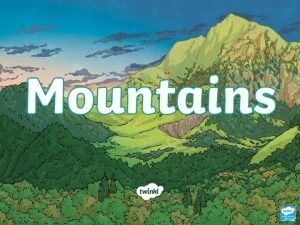What is a mountain A mountain is usually







- Slides: 7


What is a mountain? A mountain is usually defined as a part of the landscape with steep slopes that rise over 300 m. Some geographers define a mountain as a summit of at least 600 m high. Some mountains are found in groups called ranges such as the Lake District in England Snowdonia in Wales. Others are isolated summits. When mountain ranges are found together they make up mountain chains. The Alps in Europe, the Rocky Mountains in North America and the Andes in South America are all mountain chains.

Famous Mountains Mount Everest is the highest mountain in the world. It is in the Himalayas, or the border of Nepal and China, and is 8, 848 metres high. Kilimanjaro is the highest mountain in Africa. It is a volcanic mountain that is 5, 895 metres high. Mount Fuji is a volcano in Japan. It is 3, 776 metres high. Mount Mc. Kinley is the highest peak in the USA. It is 6, 294 metres high.

Famous Mountains Rocky Mountains Mount Everest Andes Kilimanjaro Mount Fuji

Mountains Temperature on a Mountain Ice on a Mountain Glaciers on a Mountains are colder Many mountains have Glaciers are made from at their peak because as ice and snow that has sharp peaks, ridges the warm air rises, it never been melted. and valleys. These are expands and cools down. As it moves down a formed by frost, ice Mountains have shiny mountain, it takes rocks and glaciers. white surfaces because with it and erodes In the summer, the of the ice and snow. It away the mountain. rain gets trapped in the reflects the sun, keeping cracks. During winter it Glaciers can leave large the temperature freezing freezes causing rocks to U-shaped valleys carved during summer. out of the rocks. split from the mountain, leaving sharp, jagged edges.

Danger on the Slopes Avalanche Altitude Sickness Cold Kills Is a huge mass of moving snow, they can contain millions of tonnes of snow and move over 300 kilometres an hour. They are normally triggered by a small shock. The snow will destroy everything in its path. The higher up the mountain you are, the thinner the air is. This means that a climber will have to take more breaths to get the same amount of oxygen as they would get if they were on the ground. Climbers can become dizzy, short of breath and tired when walking in high altitudes; this is known as altitude sickness. Climbers can get frost bite and hypothermia from the severe cold on a mountain. Both of these illnesses can kill if not treated quickly.














